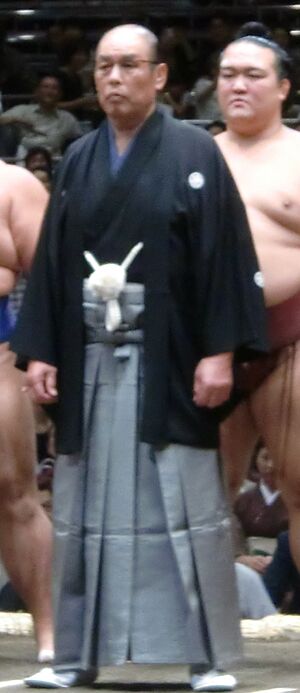Kaiketsu Masateru facts for kids
Quick facts for kids Kaiketsu Masateru |
|
|---|---|
| 魁傑 將晃 | |

Kaiketsu as chairman on the opening day of September 2011 tournament.
|
|
| Personal information | |
| Born | Teruyuki Nishimori February 16, 1948 Yamaguchi, Japan |
| Died | May 18, 2014 (aged 66) Tokyo, Japan |
| Height | 1.88 m (6 ft 2 in) |
| Weight | 128 kg (282 lb) |
| Career | |
| Stable | Hanakago |
| Record | 528–410–0 |
| Debut | September 1966 |
| Highest rank | Ōzeki (March 1975) |
| Retired | January 1979 |
| Elder name | Hanaregoma |
| Championships | 2 (Makuuchi) 1 (Sandanme) 1 (Jonokuchi) |
| Special Prizes | Outstanding Performance (2) Fighting Spirit (7) Technique(1) |
| Gold Stars | 3 Kitanofuji Kotozakura Kitanoumi |
| * Up to date as of June 2020. | |
Kaiketsu Masateru (born Teruyuki Nishimori) was a famous Japanese sumo wrestler. He was born on February 16, 1948, and passed away on May 18, 2014. Kaiketsu reached the second-highest rank in sumo, called ōzeki, not just once, but two times! He also won two major sumo tournaments in the top division.
After he stopped wrestling in 1979, he became a sumo coach. He was known as Hanaregoma-oyakata. He even started his own sumo training center, called Hanaregoma stable. From 2010 to 2012, he was the chairman of the Japan Sumo Association, which is like the main organization for sumo in Japan.
Contents
Kaiketsu's Sumo Journey
Kaiketsu started his professional sumo career in September 1966. He was 18 years old and trained at Hanakago stable. At first, he used his birth name, Nishimori.
He quickly moved up the ranks. In January 1970, he reached the second-highest division, called jūryō. He then changed his wrestling name, or shikona, to Hananishiki. Later, in November 1970, he changed it again to Kaiketsu.
In September 1971, he made it to the top sumo division, known as makuuchi. He showed great skill early on. In March 1972, he nearly won a tournament, finishing as the runner-up. He earned special awards for his amazing performance and technique.
Rising Through the Ranks
Kaiketsu continued to impress. In May 1972, he reached the san'yaku ranks for the first time, at the level of komusubi. He won 11 matches and was the runner-up again. This success led to his promotion to sekiwake, which is a very high rank. He was also a runner-up in January 1973.
In November 1974, Kaiketsu achieved a big goal. Even though he had a losing record in the previous tournament, he won his first top division championship, called a yūshō. He won 12 matches and beat the top champion, yokozuna Kitanoumi, in a special playoff match.
Because of his strong performance, the Sumo Association decided to promote him. In March 1975, Kaiketsu became an ōzeki. This is a huge achievement, as it's the second-highest rank in sumo.
Challenges and Comebacks
After becoming ōzeki, Kaiketsu faced some health issues. He was demoted from the rank less than a year later because of two losing records. But he didn't give up!
In September 1976, he made an amazing comeback. He won his second tournament championship with an impressive record of 14 wins and only 1 loss. This was followed by two more strong performances. Because of his consistent wins, he was promoted back to ōzeki in March 1977.
However, his second time as ōzeki lasted only four tournaments. He eventually fell back to lower ranks. Kaiketsu retired from sumo in January 1979. He had a remarkable career, never missing a single match in 12 years. He believed in always showing up to compete. He won two championships, ten special prizes (including seven for his fighting spirit), and three kinboshi (special wins against a yokozuna).
Life After Sumo
After retiring, Kaiketsu started his own sumo training stable, Hanaregoma stable, in 1981. One of his most famous students was Ōnokuni, who later became a yokozuna. When his old stable, Hanakago, closed down in 1985, all its wrestlers joined Hanaregoma stable. Kaiketsu also trained other top wrestlers like Hananokuni and Hananoumi.
He became a Director of the Japan Sumo Association. This meant he helped manage sumo judges and checked new sumo recruits. In August 2010, he became the head of the Association, taking over as chairman.
During his time as chairman, there was a big issue in sumo. Kaiketsu announced an investigation and even canceled a major tournament in March 2011. He stepped down from his chairman role in February 2012 because of age limits. He left the Sumo Association in February 2013. His stable, Hanaregoma, then joined Shibatayama stable, which was run by his former student, Ōnokuni.
Kaiketsu passed away on May 18, 2014, at the age of 66. He was playing golf at the time.
Kaiketsu's Fighting Style
Kaiketsu had a powerful and effective fighting style. His favorite techniques, called kimarite, included:
- tsuppari: A series of quick pushes to the opponent's chest.
- hidari yotsu: A specific way of gripping the opponent's belt (mawashi) with his left hand inside and right hand outside.
- yori kiri: Forcing the opponent out of the sumo ring while holding their belt.
- uwatenage: An overarm throw, where he would use his arm over the opponent's shoulder to throw them down.
See also
- Glossary of sumo terms
- List of sumo tournament top division champions
- List of sumo tournament top division runners-up
- List of past sumo wrestlers
- List of ōzeki

